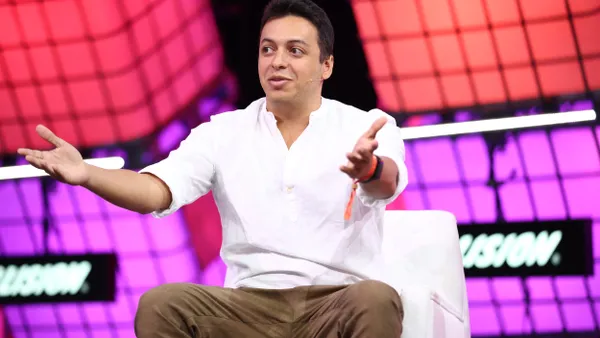The HR function is at a crossroads. Speedy technological shifts are forcing organizations to behave differently — to be innovative, collaborative and agile. Organizations must change their structures, processes and people management practices to make that happen. And those organizations need HR's leadership.
But HR itself is in a quandary. As a department, it's in the midst of incorporating emerging technologies like artificial intelligence (AI), machine learning and virtual reality to increase efficiency, while also seeking to improve employee engagement and ensure that today's workforce is prepared for the future of work.
To do that, HR must become a strategic partner of the organization, but too often the department is seen as merely the gate keeper of policies and processes — and the one to avoid when you really want to get something done.
Solving HR's midlife crisis
The answer may lie in the quest to harness the disruptive technology itself, according to Enrique Rubio, HR and tech evangelist and founder of Hacking HR. “This is the perfect opportunity for HR to use technology as an excuse to change,” Rubio said during a Hacking HR presentation this month.
During disruption, organizations and departments can re-invent themselves to add more value, he said; “changing HR from its core, from its very heart, I think that’s one of the things we need to do today.” The technological changes are just a small part of the changes HR needs to implement. “People in HR tend to think of what system, what tools we need, not how do we need to change the work we do or about the tools do we need to use to make those changes happen," he said.
HR's initial forays into technology
It’s not that HR has ignored emerging technologies. To the contrary, HR is experimenting with new potential solutions, especially in recruiting. For example, companies are using machine learning to create unbiased job descriptions. By eliminating the so-called “brogrammer” masculine superlatives and phrases, more qualified applicants might apply, leading to larger hiring pools.
Likewise, AI is used to sift through a bigger pool of applicants, often coded to ignore details that a human might unconsciously notice that aren’t related to the ability to perform the job, such as gender, age or race. Virtual reality, too, is being used to help with diversity training, allowing employees to immerse themselves in situations that address unconscious bias.
These technologies are paving the way for improvements in other areas of HR, too. New employees can receive additional assistance while onboarding from chatbots that can answer questions and direct employees to resources, for example.
“Post-recruitment is another neglected process, where technologies such as Enboarder try to bridge the gap of personalization and scale in order to deliver a great candidate experience from the onset of a person’s employment while ensuring an organization’s governance processes are observed,” Neil Cains, founder and chief technology officer of Allegis Group’s Innovation Lab, told HR Dive.
Succession planning and attrition management is ripe for tech intervention, too. “The ‘propensity to move’ metric is a big deal in the industry,” Cains said. “So, firms like hiQ scrape publicly available data from social profiles and combine it with internal HR data from client-customers to project employee attrition rates or identify talent likely to be recruited away. Armed with such information, businesses can begin eying the right next step for an employee and are better prepared to backfill a position if that person does decide to leave.”
These tools can help HR provide additional transparency, Cains said. During an applicant screening process, for example, AI can provide applicants with feedback on why they were not selected. “AI can do that at scale…it can help bridge that gap when it is impossible to do that for many large businesses,” he explained, adding that this transparency can lessen applicant frustration and create a better brand for the employer.
But as with any technology, tools must be used in a way that creates space for HR professionals to spend more time on valuable and strategic work, he said.
How can HR lead the disruption?
Rubio suggests four steps for HR leaders to emerge as strong business strategists and, perhaps surprisingly, the use of technology is last on the list:
- HR leaders need to create a new value proposition, beginning by looking at how their departments operate within the company and how employees are treated. A people-centric approach is necessary for improving the employee experience. Simple behaviors like listening, coaching and providing leadership opportunities can be a start.
- HR should find ways to help align people with their interests and the company’s goals. Helping people find meaning in their jobs will help them bring their best, he said. “If you can find that one thing and connect it to the purpose of your business, that’s the Holy Grail,” he said.
- HR should be willing to match their systems and processes with the speed of business, Rubio said. That means taking an agile approach to making small but definite changes, and making improvements as you progress. “Pilot; scale; iterate,” Rubio said.
- Embracing technology as a tool is the final way HR can help lead, Rubio said.
Aaron Crews, Chief Data Analytics Officer at Littler Mendelson, agrees. With any technology, you still need people who can check to ensure the technology is doing what it was designed to do, Crews said. “From an HR perspective, understand that technology is part of a greater process," he said; "it needs to be rolled into a process that is human driven, where you have humans making the decisions."
Organizational executives understand the benefits of a fully engaged, dedicated employee base that is primed for HR to lead the way, Rubio said. HR leaders often say they want a seat at the table. Rubio has different advice: “Stop waiting for an invitation."
By taking the first steps in adding value with and without technology, HR leaders can demonstrate they deserve a voice, he said.
For HR professionals who are concerned that the implementation of more technologies means fewer opportunities for humans, consider the top skills needed by 2020: complex problem solving, critical thinking, creativity, people management, coordinating with others and emotional intelligence. These abilities rely on human experience, not on coded programs. By assigning more repetitive or mundane tasks to technological tools — and focusing on the ability to implement higher level thinking — HR can use human skills to be at the forefront of change.




















